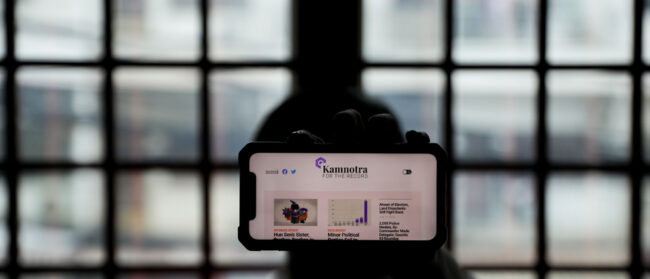Five children stopped and stared. Before them lay a brutal scene. A man, nearly naked, was knelt in the dirt. Two other men, standing either side of him, were using bamboo poles to squeeze his neck. The first man’s eyes rolled back into his head.
The children were in no physical danger – it was only a diorama at the Museum of Communist Treachery in Jakarta. Their sense of history, however, is unlikely to have left this place unscathed. The scenes here present a twisted view of a period that culminated in the slaughter of hundreds of thousands of alleged communists and set the stage for General Suharto’s 32-year dictatorship.
Indonesia is full of propagandist museums and monuments, especially ones celebrating the murderous purge. But in light of recent initiatives to re-examine the past, such as The Act of Killing, Joshua Oppenheimer’s documentary about former death squad leaders in Indonesia today, the displays take on new significance.
The museum lays out communist misdeeds from 1945, when Indonesia declared independence, to 1965, the year Suharto took power, and beyond. About 30 vivid dioramas put forth the simplistic and, in key parts, unsubstantiated narrative on which Suharto’s New Order regime based its legitimacy.
This official version holds that, for 20 years, the Indonesian Communist Party (PKI) waged a relentless campaign to undermine the republic and suit its own murky ends. On the morning of October 1, 1965, these godless, bloodthirsty extremists finally went too far when, using their ‘puppets’ in the military, they killed seven high-ranking army officers in an attempted coup. They didn’t get far: That same day, Suharto took command of the army and averted the coup. Six months later, acting on a mandate from then President Sukarno, Suharto issued a decree banning the PKI, thus restoring order to the nation.
“This decree received a warm welcome from all the Indonesian people,” reads the text accompanying Diorama 32, which depicts masses of Jakartans holding a victory parade and waving posters “to express their happiness and thanks”. Aside from a few slides showing mop-up operations against remnants of the PKI, that’s roughly the happy end of it, a fairy tale finish from a man who fancied himself the ‘father’ of the people. The moral of the story appears writ large on the wall by the exit. “Don’t let events like this happen again,” the text implores. “Enough drops of blood and tears have wet the motherland.”

This official version is rife with inconsistencies. Books have been written about how the story doesn’t add up. Suharto’s claim that the PKI orchestrated the coup has repeatedly been called into question. Some say it was an internal army affair, with the PKI barely involved; others argue Suharto himself organised it so he could take power. Most convincingly, John Roosa writes in Pretext for Mass Murder (2007) that while certain PKI leaders were “undeniably” involved, they almost certainly did not mastermind the coup. Moreover, Suharto’s faction in the army, who with American help had already drawn up contingency plans to blame the PKI for an attempted coup – the perfect pretext for an attack on the party – had been waiting for an opportunity to put those plans to use. When the first group of army officers struck, Suharto’s faction was ready and waiting.
Last year, Indonesia’s National Human Rights Commission (Komnas HAM) released the results of its four-year investigation into the slaughter that followed Suharto’s seizure of power. In interviews with hundreds of survivors, the commission found that “crimes against humanity” occurred and that the military was responsible. It urged further investigation by the attorney general and suggested that a Truth and Reconciliation Commission be established. State authorities largely rejected the report, but “it has provoked public debate and brought new attention to 1965… and it has forever changed the focus of the debate”, Ronnie Haley wrote in the Apr-Jun 2013 issue of Inside Indonesia.
The museum makes no mention of the mass killings. It is too busy demonising the communists. Vivid dioramas depict them abusing Muslims, attacking civil servants, executing prisoners, plundering villages, holding nefarious meetings and milling about subversively. Diorama 10, titled “Mass Murders in Tirtomoyo (4th October 1948)”, presents a particularly graphic description of PKI atrocities. The text says PKI captives were “stabbed with sharpened bamboo poles and bayonettes [sic] or neck strangled with wire. Some were even stoned to death with their hands tied.”
Those words recall Anwar Congo, the main protagonist in The Act of Killing. The film centres on death squad leaders from the 1960s who remain prominent in Indonesian society and brag about what they did. In one scene Anwar describes the techniques he used to kill leftists. “I choke them to death, with steel wire around the neck,” he says, demonstrating for the camera. “And then pull it, sometimes with a pole. It’s easier that way and less blood to clean.”
If the museum demonises the victims, The Act of Killing humanises the killers. Anwar boasts and swaggers around, but as his inner turmoil becomes clear, watching him struggle becomes difficult. Other death squad figures appear similarly warped. By the film’s end the viewer can almost empathise with the murderers. Anwar is not so different from us.
“If we have any hope of learning how these things happen and thereby preventing them from happening again, we have to discard this fantasy that there are monsters out there, that we just have to be vigilant and lock them up and maybe kill them or put them in camps,” Oppenheimer told The Guardian. “There needs to be a thorough rewriting of the nation’s history, its history curriculum in the schools. They need to close all the museums and monuments that celebrate the genocide, and turn those into exhibits in a much larger network of Indonesian holocaust museums.”


